Set against the stunning backdrop of desert sunsets and towering saguaros, the birds of Arizona offer an enchanting display for enthusiasts and casual observers alike. Whether you’re a seasoned birder or exploring the pastime for the first time, Arizona birdwatching is an adventure that indulges your senses and elevates your appreciation for the region’s natural splendor.
Bird species that highlight the great state of Arizona, include: Arizona Hummingbirds, Cactus Wren, Roadrunner, American Goldfinch, Baltimore Oriole, Black Phoebe, Northern Cardinal, Blue Heron, Gila Woodpecker, Mexican Chickadees, Black Hawks, Wood Ducks, Blue Grosbeak, and the curve-billed thrasher.
Your journey into this vivid world affords a peek at the myriad Arizona bird species, spanning vibrant hummingbirds to the stately Great Blue Heron. Each state park unfurls a fascinating story where you become the protagonist, guided by an innate sense of wonder and a handy species identification guide to aid in Arizona bird identification. With every visit, the collection of common Arizona birds will become more like old friends, familiar by sight and song, enhancing your connection to the land’s wild heart.
Prepare to have your binoculars at the ready and let Arizona’s avian melody guide you to its most secluded hideaways and bustling habitats. Ready to begin?
Key Takeaways
- Engage with the dynamic diversity of Arizona birds in various state parks.
- State parks offer world-class birdwatching coupled with identification guides for enhanced experience.
- Understand and appreciate the rich bird species that define Arizona’s distinct ecosystems.
- Equip yourself with knowledge and gear to excel in Arizona bird identification.
- Marvel at the common Arizona birds, each with its unique beauty and characteristics.
An Introduction to Birdwatching in Arizona’s Varied Habitats
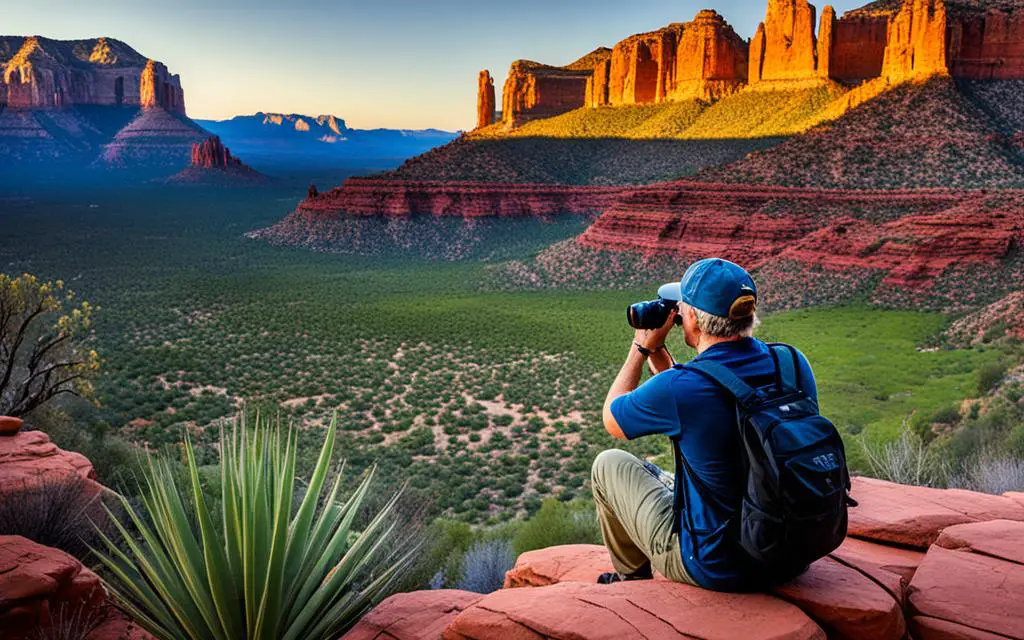
Welcome to the vibrant world of Arizona birdwatching, where the thrill of observing some of the most diverse and captivating bird species awaits you. Whether you’re drawn to the majestic desert birds of Arizona or are keen on attracting birds to your yard in Arizona, the state’s range of ecosystems provides a paradise for birders of all interests and skill levels.
Why Arizona is a Birding Paradise
From the serene waters of the Colorado River to the stately cacti of the Sonoran Desert, Arizona’s habitats offer a cornucopia of avian treasures. The state’s unique geological features create a variety of microclimates that are home to an array of bird species, easily cementing its status among the best Arizona birding spots. Whether it’s the flitter of hummingbirds or the soaring grace of raptors, there’s a spectacle for everyone in this birding hotspot.
Essential Gear for an Arizona Birding Adventure
To fully immerse yourself in the birding experience, proper gear is essential. Durable boots can navigate the terrain of Arizona’s birding hotspots, while layered clothing will keep you comfortable through the state’s variable climates. High-quality optics, such as eight power binoculars, are indispensable for spotting desert birds in Arizona, allowing you to see every detail as you peer across vast distances or into thick foliage.
Navigating Arizona’s Best Birdwatching Locations
Exploring the best birding nooks in the Copper State can be both exciting and overwhelming. To aid your adventure, state parks provide species lists for previewing potential sightings. From the lush riparian zones to sun-soaked deserts, knowing where to look is pivotal. Here’s a snapshot of what you might encounter and where:
| Location | Habitat | Common Birds |
|---|---|---|
| Riparian Zones | Wetlands, Rivers | Black Hawks, Wood Ducks |
| Desert Landscapes | Deserts, Cacti Forests | Cactus Wren, Gila Woodpeckers |
| Mountain Foothills | High Elevation Forests | Anna’s Hummingbird, Mexican Chickadees |
Remember, whether it’s a park with a storied birding reputation or your own back garden, every location offers the potential to observe and enjoy the avian life that thrives in the diverse ecosystems of Arizona.
The Vibrant Avian Life of Northern Arizona State Parks
Immerse yourself in the bird watching Arizona scene and discover the backyard birds of Arizona that adorn the vast landscapes of the state’s northern parks. With the flutter of wings in the canopies and the soft calls that echo through the air, these havens offer an idyllic setting for anyone eager to appreciate the versatility of avian life. As you plan your visits, keep in mind, the best time for bird watching in Arizona often lies in the early quiet of dawn or the tranquil twilight hours, when birds are most active.
Exploring the Diverse Species at Dead Horse Ranch State Park
At Dead Horse Ranch State Park, the Verde River’s riparian chorus and the cottonwood-willow galleries set the stage for an array of bird species. Listen for the trill of black hawks and gaze upwards to spot the determined flight of bald eagles. The park’s varied habitat supports a dazzling spectrum of birds, making every visit a unique encounter with Arizona’s feathered residents.
Feathered Wonders of Red Rock State Park
In the heart of Sedona’s iconic landscape lies Red Rock State Park, where the red hues of the rocks provide a striking backdrop for bird watching. Watch for wrens flitting among the underbrush, swallows swooping over the water, and the occasional regal flight of hawks and eagles. This park is not just a visual feast but a haven for both resident and migratory waterfowl that grace the waters with their presence.
Lakeside Birding at Lyman Lake State Park
A stone’s throw from U.S. Highway 191, Lyman Lake State Park offers a serene escape where the still waters meet the sky. Here, blue herons stand as statues along the shoreline, and waterfowl gather in awe-inspiring rafts on the lake. It’s a place where bird watchers can observe the aquatic dance of nature and record sightings of ducks, geese, and other species that treat the lake as a welcome stopover on their migratory paths.
Southern Arizona’s Birdwatching Gems
When you venture into the heart of Southern Arizona, you’ll uncover enchanting landscapes of cacti and canyons that play host to an eclectic mix of bird life. From the trill of Arizona hummingbirds to the assertive call of Arizona quail, these parks are a birder’s sanctuary, offering a unique view into the lives of some of Arizona’s most charismatic feathered residents.
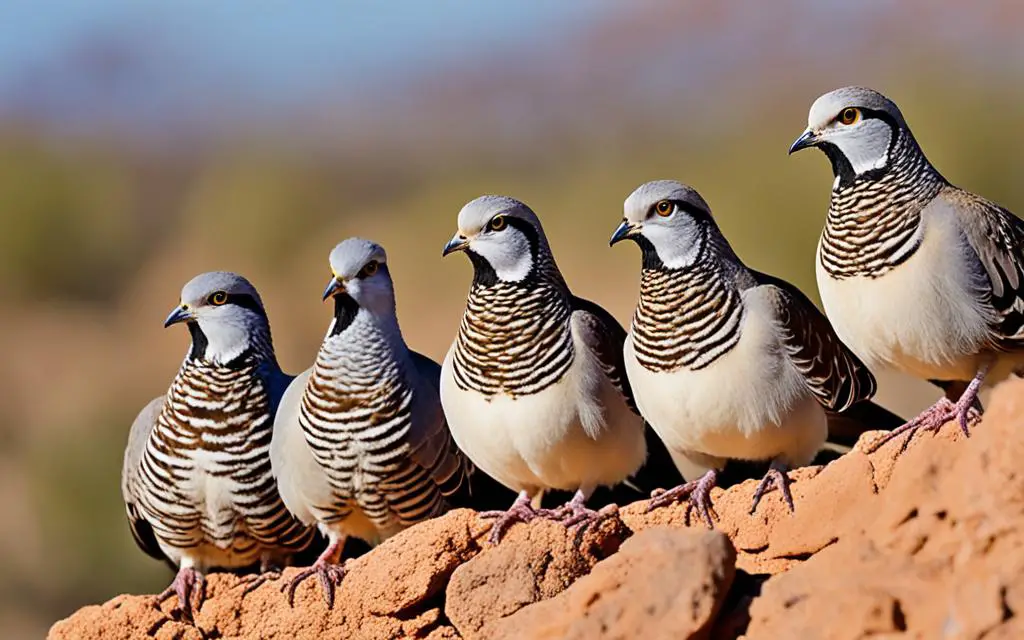
Desert Birding at Kartchner Caverns State Park
Within the labyrinthine trails that weave through Kartchner Caverns State Park, you are likely to encounter the delicate dance of Arizona hummingbirds alongside the winged shadows of owls gliding over the desert shrubs. It’s here, where sparrows join the symphony, that Arizona’s desert birds reveal their beauty against the backdrop of the state’s rugged terrain.
Water’s Edge Wonders: Patagonia Lake State Park
Patagonia Lake State Park’s waters are a magnetic pull for birders, where the rippling surface mirrors the flight of rare avian species. It’s a place famed not just for visiting Arizona woodpeckers but also for sights of elegant trogons and vigilant vultures soaring overhead, showcasing the park’s reputation as a hotspot for bird diversity.
Picacho Peak State Park: A Desert Bird Haven
At the iconic Picacho Peak State Park, the desert becomes a haven where Arizona doves and quail sprinkle the saguaros with life. The sharp-eyed may catch glimpses of hawks and falcons, pinpointing the park as a pristine enclave for birds that call the arid majesty of Southern Arizona their home.
From dawn’s first light until dusk’s gentle retreat, the birds of Southern Arizona provide a display that’s as varied as the landscape itself. Bring your binoculars and allow yourself to be delighted by the elusive wingbeats and vibrant songs that fill the air in these nature-rich sanctuaries.
Understanding Arizona’s Bird Migration Patterns
The annual procession of Arizona bird migration patterns is a remarkable phenomenon that transforms the state’s skies into corridors of avian movement. Acquainting yourself with these patterns is not just a matter of wonder but practicality, deepening your birdwatching experience and guiding you on where to find birds in Arizona at various times of the year.
Arizona serves as a crucial nexus for migratory birds, with species such as ducks, hawks, and hummingbirds making their seasonal passage. These migrations are prompted by the instinctual need for breeding grounds, favorable climates, and abundant food sources. The understanding of these movements is key, as it allows you to anticipate and strategically plan your visits to state parks and hotspots at optimal times. To illustrate this, a table of commonly seen species and their migration periods in Arizona has been crafted for your convenience.
| Species | Spring Migration | Fall Migration |
|---|---|---|
| Ducks | February – March | October – November |
| Hummingbirds | March – May | August – October |
| Hawks | March – April | September – October |
Whether you’re an early riser setting out at dawn or someone who revels in the cooler hours of dusk, these timeframes heighten the likelihood of witnessing the spellbinding passage of birds across Arizona’s grand landscapes. Keep your binoculars at the ready and peer into the open skies and sheltered retreats that Arizona offers. As you stand witness to these ancient migratory sojourns, you become part of a lineage of observers stretching back through the ages, all united by a singular passion for the wonders of the winged world.
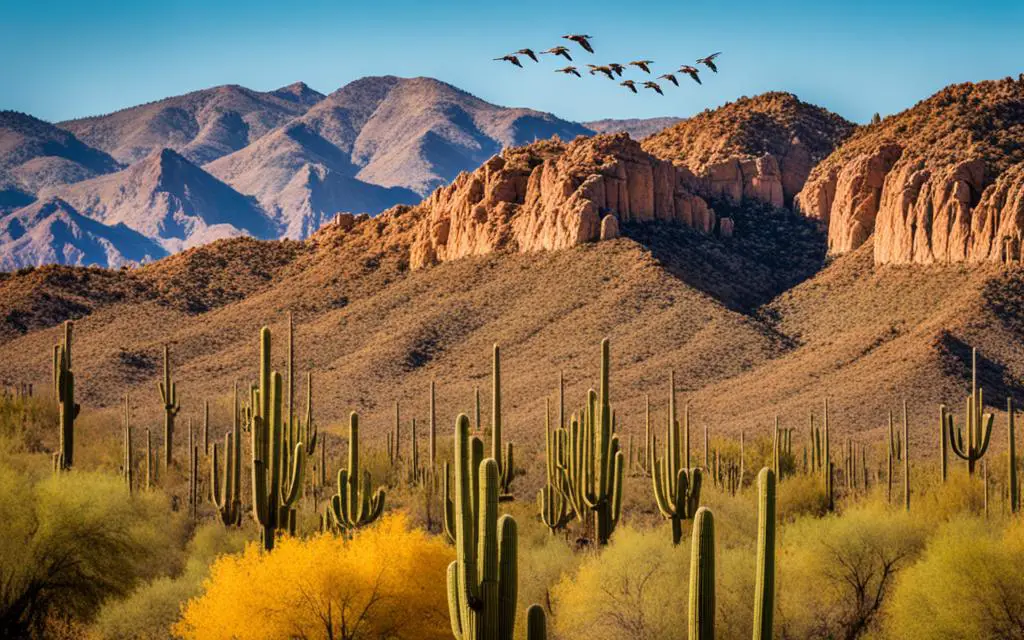
What Are the Most Common Birds in Arizona?
As you explore the Arizona birdwatching scene, you’ll quickly become familiar with some of the most seen feathered residents. The gentle cooing of doves, the robust calls of raptors, and the melodious songs of the numerous songbirds fill the air, creating a mosaic of nature’s music that is as rich as the landscape itself. Below, you will find a table that features some of the most common birds you might encounter, including the iconic Arizona raptors, the watchful Arizona owls, sociable Arizona finches, and the soaring Arizona hawks.
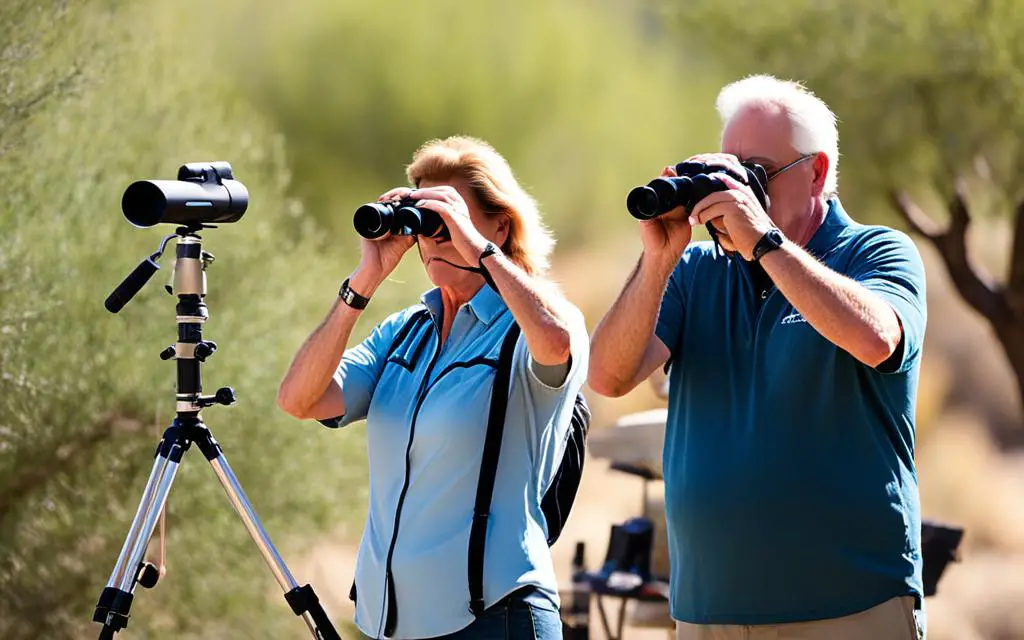
| Category | Common Species | Details |
|---|---|---|
| State Bird | Cactus Wren | Largest North American wren, known for its distinctive white eyebrow stripe and spotted chest. |
| Hummingbirds | Anna’s Hummingbird | Luminous emerald feathers and captivating rose-pink throats, frequently spotted in backyards. |
| Sparrows | Black-Throated Sparrow | A desert specialist with a striking black throat and white face, often found near brushy areas. |
| Cardinals | Cardinal | Vivid red plumage with a crest on their heads, offering a splash of color against any Arizona backdrop. |
| Quails | Gambel’s Quail | Characterized by their top knots and scaled appearance, often seen scurrying with their broods. |
| Woodpeckers | Gila Woodpecker | Adaptable residents of desert regions, known for creating cavities in saguaro cacti. |
| Ground Runners | Greater Roadrunner | Distinctive long-legged birds with a penchant for running, famed for their expressiveness and speed. |
| Migratory Birds | White-Winged Dove, Red-Tailed Hawk | Doves are symbols of peace with unique wing markings; hawks are raptor royalty with their broad, rounded wings. |
You’re likely to spot these avian celebrities in a variety of habitats, from the depths of the Sonoran Desert to the cooler climes of mountain forests. Keen observers may also catch a glimpse of Arizona owls silently gliding in the dusk or hear the exhilarating cry of Arizona hawks as they survey their domain from lofty heights. Among the brush and blooms, Arizona finches add a dash of color and song, enlivening any birding expedition with their lively chatter.
Whether you’re starting in your backyard or venturing into the vastness of Arizona’s state parks, these common species are the perfect introduction to the rich tapestry of bird life that the Grand Canyon State has to offer.
Arizona Bird Identification Techniques
Embarking on the rewarding journey of Arizona bird identification can be both exhilarating and educational. As you traverse the diverse landscapes of the Grand Canyon State, it’s essential to know the hallmark characteristics that differentiate the myriad of species. From the distinct profile of raptors in flight, to the intricate pattern of a sparrow’s plumage, each bird presents a new challenge in identification. With keen observation and the right approach, even the cryptic outline of a curve-billed thrasher amongst the desert scrub becomes a recognizable sight.
Success in identifying birds often starts with appreciating the nuance in their vocalizations. Each chirp, squawk, and warble serves as an auditory signature that, once familiar, can reveal the identity of a bird even before it’s in sight. Additionally, understanding seasonal plumage changes and species-specific behavior will further refine your birdwatching skills. A well-thumbed field guide is an indispensable tool, providing illustrative assistance on-the-go for quick reference.
Don’t underestimate the value of learning about the local flora too; the unique vegetation of Arizona’s landscapes is more than just a backdrop—it’s a vital part of the habitat birds rely on. Recognizing specific desert plants often leads to spotting the birds that frequent them for food, shelter, or nesting. Armed with these identification strategies, the rich avian tapestry of Arizona unfolds before you, turning every outdoor excursion into a potential discovery of winged wonders.
Table: Identifying Common Residents and Winter Visitors
| Bird Species | Identifying Features | Frequented Habitats |
|---|---|---|
| Cactus Wren | Distinct white eyebrow stripe, spotted chest | Cactus forests, desert scrub |
| Gila Woodpecker | Barrel-shaped black and white spots on wings, red cap (males) | Saguaro cacti, tree cavities |
| Curve-Billed Thrasher | Long down-curved bill, spotted chest, yellow eyes | Desert thorn scrub, mesquite groves |
| Anna’s Hummingbird | Iridescent emerald feathers, rose-pink throats (males) | Flowering plants, feeders |
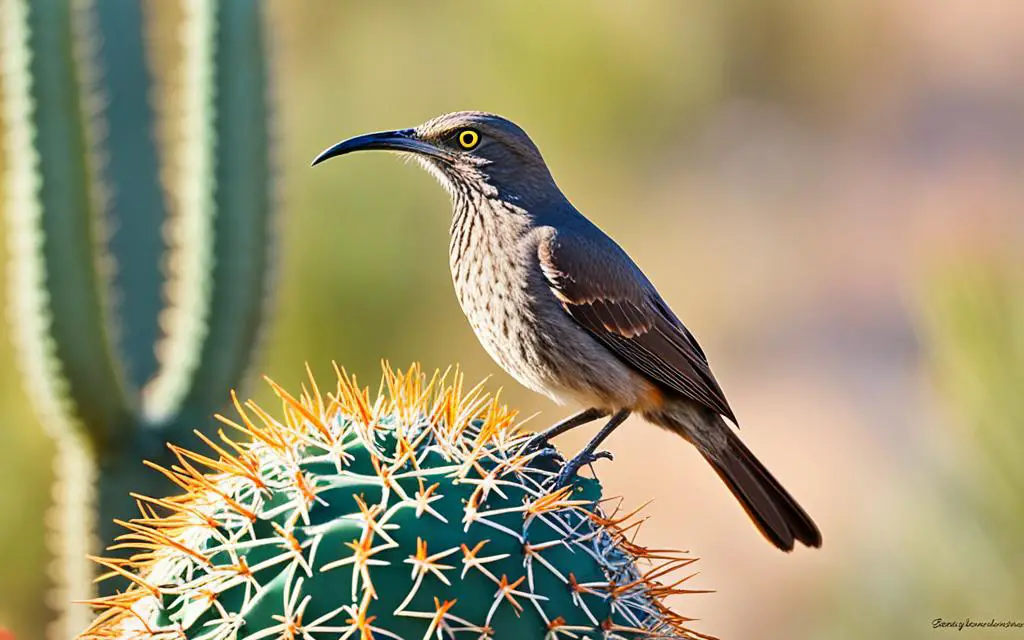
The majestic curve-billed thrasher is an iconic desert dweller and recognizing one can be a highlight of any birdwatching outing. Key to identifying this bird is its eponymous long, downward-curving bill, perfectly evolved for foraging in the tough desert soil. Take note of their distinctive bright yellow eyes and the soft patterning on their breast—a stark contrast to the mostly brown body. These birds are commonly found amidst the dense brush and cholla cacti of Arizona’s deserts, making it a thrilling challenge for birders to pinpoint.
Remember, patience and persistence are virtues in the art of birdwatching. Over time, your experiences in Arizona’s great outdoors will deepen your identification skills, amplifying the joy of each new avian acquaintance. Engage, observe, and treasure the ecological richness that birding in Arizona provides.
Seasonal Behaviors: When to Find Birds in Arizona
Arizona’s skies and landscapes transform seasonally, welcoming an array of migratory birds and exhibiting the daily rhythms of resident species. To align your birdwatching escapades with nature’s timetable, understanding both the seasonal migrations and the daily patterns of bird activity is crucial.
Timing Your Visit for Optimal Birdwatching
If you’re pondering what time of day are birds most active in Arizona, you’ll find the dawn chorus as your prime opportunity. The early hours are not only cooler, providing relief from the Arizona heat, but also when birds are bustling with activity. It’s the best time to watch as they forage for food, interact with mates, or display their melodious songs. A peaceful morning venture offers a symphony of avian life that is rarely paralleled during other times of day.
Spotting Migratory Birds Through the Seasons
Change is a constant in the natural world, and so are the habits of Arizona’s birds. As the state enjoys various migratory visitors, staying attuned to the shifting seasons is key. From hummingbirds to hawks, each species has its preferred timeframe to traverse the skies above the diverse Arizona terrains. To make the most of these migratory spectacles, staying informed on the cyclical bird movements is essential.
But birdwatching in Arizona isn’t just about observation—it’s also about providing an inviting environment. When considering how to make a bird bath for Arizona birds, think about the safety and accessibility of these hydration stations. Ensure they are placed away from potential predators and in a shaded area to keep the water cool. A bird bath can transform your yard into an oasis for these desert travelers, encouraging them to linger for your viewing pleasure.
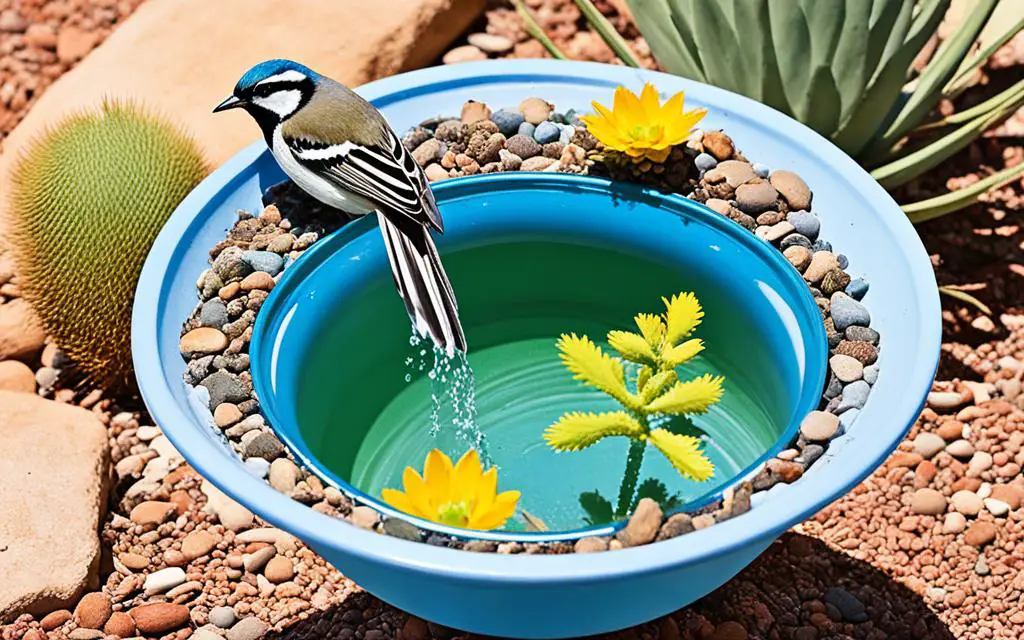
Creating a Backyard Haven: Arizona Bird Feeder Tips
Transform your Arizona backyard into a vibrant bird sanctuary with our insightful arizona bird feeder tips. The melodious charm of songbirds and the delicate fluttering of hummingbird wings can add life to your personal outdoor space, making it a retreat for both you and the local bird population.
Attracting Backyard Birds in Arizona
Attracting birds to your yard in Arizona can be a delightful and interactive way to connect with nature. One of the most rewarding experiences is when you learn how to attract cactus wrens to your Arizona yard, bringing the state bird right to your doorstep. Start with natural landscaping, incorporating native plants that offer birds their natural food and habitat. Adding a water feature or bird bath will also encourage avian visitors by providing them with a necessary resource for drinking and bathing, especially in the arid climate.
Choosing the Right Feeders and Food for Arizona Birds
Finding the best bird feeders for Arizona birds means understanding the specific needs and diets of local species. Tube feeders are perfect for small seed-lovers like finches, while platform feeders can accommodate a variety of birds, including the cactus wren. For hummingbirds, nectar feeders are a must. Ensuring feeders are clean and well-stocked with fresh food, such as sunflower seeds or suet, will keep your feathered friends returning season after season.
| Bird Species | Feeder Type | Food Choice |
|---|---|---|
| Hummingbirds | Nectar Feeders | Sugar water mixture (1 part sugar to 4 parts water) |
| Finches | Tube Feeders | Nyjer or Thistle Seed |
| Cactus Wrens and Sparrows | Platform Feeders | Insects, Fruits, Crumbles, and Seeds |
| Quail and Doves | Ground Feeders | Millet, Cracked Corn |
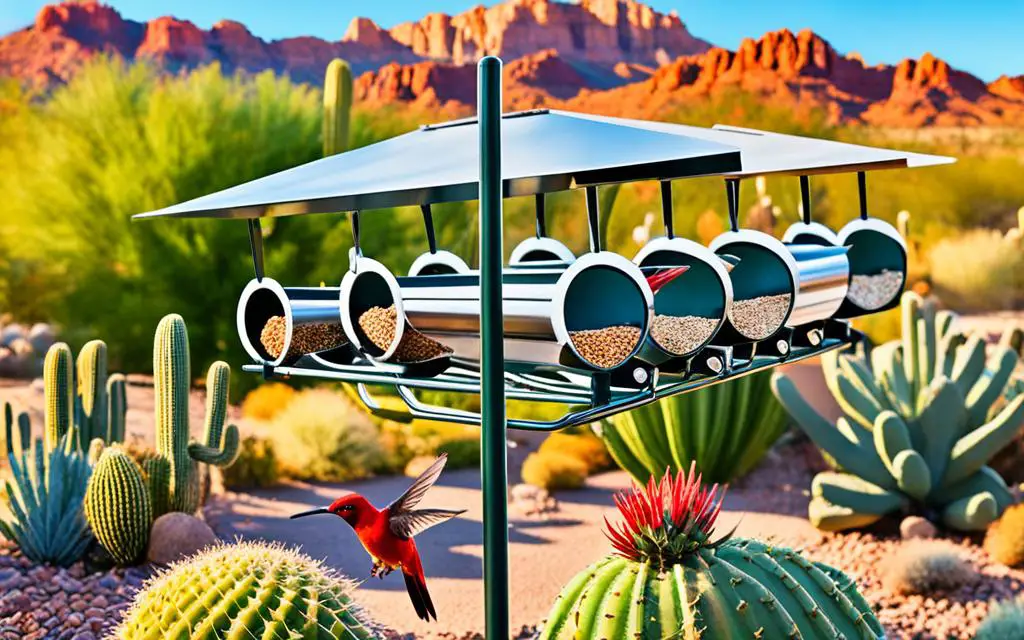
A tip to remember when setting up your feeder station is to place it near natural cover, like bushes or trees, to provide escape routes for birds if predators are near—but not so close that predators can hide within pouncing distance. By creating a safe and attractive environment, you can enjoy the spectacle of Arizona’s bird variety from the comfort of your home.
The Eclectic Songbirds of Arizona
As the sun rises over the expansive Arizona landscape, the air is filled with more than just the light of a new day. It’s also alive with the songs of arizona songbirds, a rich tapestry of melodies that tell the story of the desert’s diverse ecosystem.
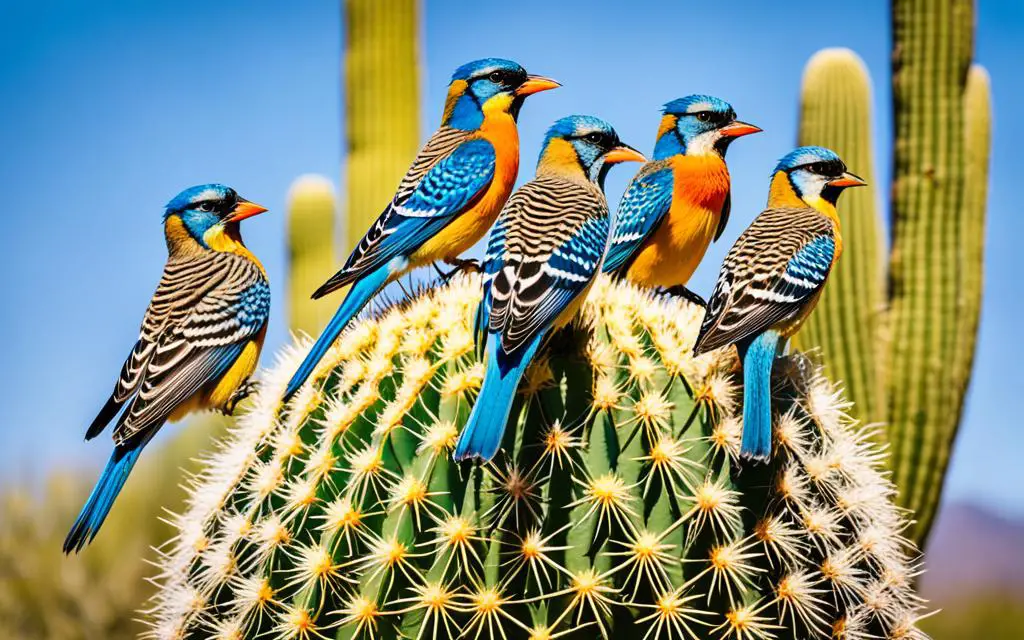
Getting to Know Arizona’s Signature Songbirds
You might start your morning with the profound songs of the northern cardinal, a striking flash of red against the pale desert backdrop. As the day unfolds, the gentle cooing of the mourning dove adds a soothing tempo to the soundscape, while the distinctive call of the curve-billed thrasher rings out from the thorny brush. These are just a few of the characters in the symphony that is birdwatching in Arizona.
Listening to the Melodious Tunes of Local Species
Each songbird holds a special place in the heart of Arizona. Breathe in the dawn air and let the northern cardinal serenade you with its rich whistles, varying in sequence but always full of fervor. In contrast, the mourning dove’s soft, woeful coo carries across the quiet, scaling the morning’s calm. And then there’s the curve-billed thrasher, with its jumbled chorus of whistles and chirps that can’t help but bring a smile to the faces of those lucky enough to hear it.
Here are some interesting facts about arizona bird songs: the northern cardinal has over 24 different song variations and the curve-billed thrasher is known to aggressively defend its territory with a robust repertoire of vocalizations. These birds, among others, fill the state not just with color and movement, but also with their enchanting music.
To truly appreciate the musicality of these birds, take a moment to simply listen. Close your eyes, focus your senses, and dive into the mesmerizing world of these auditory treasures.
Discover, experience, and enjoy the natural concert that these Arizona songbirds provide. It’s a performance that requires no ticket and happens to be playing right in your backyard.
Conservation Efforts and The Importance of Protecting Arizona’s Birds
The breathtaking variety of birds in Arizona, including the celebrated Arizona state bird, the Cactus Wren, underscores the vital importance of nurturing and preserving these natural treasures. With each wingbeat and song, they enrich our environment and foster a deeper connection to our planet’s biodiversity. Observing the grace of a hawk in flight or the unique desert behavior of a Roadrunner, makes clear why bird conservation efforts in Arizona are fundamental not just for the birds themselves but for the ecological balance and the enjoyment they offer to humanity.
However, the increased human-induced pressures on their habitats call for a considerate and concerted approach to ensure their survival and prosperity. Development, pollution, and climate change are just a few of the factors that impact the viability of avian habitats—threatening the very existence of these remarkable species and the roles they play in the ecosystem.
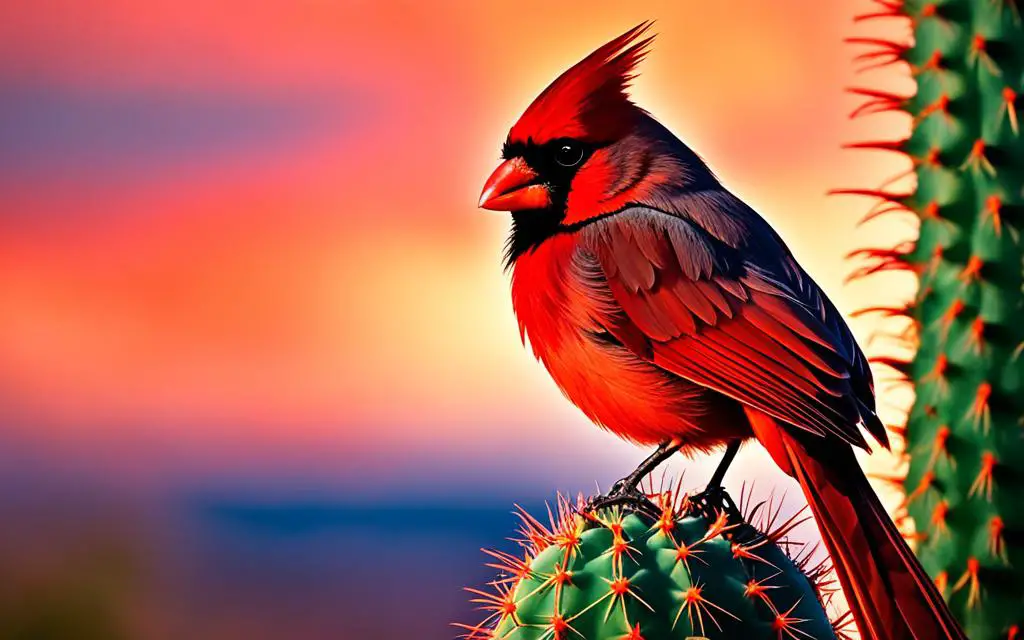
Understanding Human Impact on Arizona’s Avian Habitat
The beautiful chorus of Arizona’s birdlife is under threat due to expanding urbanization and resource exploitation, fragmenting and diminishing available habitats. The disruption of migration patterns, nesting grounds, and food sources, coupled with the broader effects of climate change, leaves many species vulnerable. Knowledge of these impacts empowers us to take action and implement changes that facilitate the coexistence of human progress with the natural world.
How You Can Help in Bird Conservation Efforts
Everyone has a role to play in safeguarding the birds of Arizona. By engaging in habitat preservation initiatives, indulging in bird-friendly practices, and contributing to citizen science programs, your involvement can make a significant difference. Participation in local conservation groups and the national Audubon Society’s programs not only helps protect bird populations but also enhances the overall environmental health for future generations.
Simple actions such as creating bird-friendly yards with native plants, minimizing window collisions with decals, and keeping cats indoors are pivotal in preserving avian life. Moreover, supporting bird-friendly legislation and advocating for crucial habitat conservation efforts are instrumental ways to contribute to the larger movement of wildlife preservation.
| Action | Impact | How to Get Involved |
|---|---|---|
| Creating Bird-Friendly Spaces | Provides birds with safe habitats and food sources | Plant native species, install bird baths and feeders |
| Advocating for Conservation | Protects critical bird habitats | Support local and national conservation policies |
| Engaging in Citizen Science | Provides data for research and conservation | Join bird counting and monitoring projects |
| Educating Others | Spreads awareness on bird conservation | Host workshops, write articles, share on social media |
Through these actions, you become an integral part of the bird conservation efforts in Arizona, contributing to the endurance and thriving of these splendid creatures. Let’s cherish and protect the avian wonders of Arizona, not only for their ecological importance but also for the joy and beauty they provide to our lives.
Conclusion
As you come to the end of this reading journey, the enchanting world of Arizona birdwatching beckons. The Grand Canyon State, a mosaic of varied habitats and mesmerizing avian life, is more than just a pastime—it’s a gateway to experiencing nature in its purest form. Whether you’re in the sun-drenched deserts, by the meandering rivers, or at the heights of the pine-clad mountains, the birds of this region are companions on your journey, ever-present and vibrant.
Embarking on Your Arizona Birdwatching Journey
Your quest to uncover the myriad species that soar above and flit between the terrestrial tapestry of Arizona is not just about ticking off names on a list—it’s about immersion and connection. As you step out with binoculars in hand and the serenade of birds in your ears, remember that each sighting is a story, a living brushstroke on the canvas of our shared ecosystem. The joy of birdwatching is found in these moments, these flashes of color and song that stay with you long after you’ve returned home.
Why Birding Matters: The Joy of Avian Observations
Why birding matters is a question answered by the flutter in your chest when you spot an elusive species for the first time, or the awe that fills you as you watch migratory patterns play out above. It’s in the thrill of recognizing the call of a cactus wren or the sight of a hummingbird as it pauses in its aerobatic dance. Birding elevates your appreciation of nature’s nuances and diversity and brings a sense of wonderment to your everyday life. So, take this knowledge, your gear, and a spirit of adventure, and delve into the joy of birdwatching within Arizona’s breathtaking landscapes.
FAQ
What are the most common birds in Arizona?
Why is Arizona considered a birding paradise?
What gear do I need for an Arizona birding adventure?
Where are the best birdwatching spots in Arizona?
When is the best time for bird watching in Arizona?
How can I attract birds to my Arizona yard?
Are there any distinctive Arizona birdwatching experiences I shouldn’t miss?
How do I identify birds in Arizona?
Can I participate in bird conservation efforts in Arizona?
What conservation strategies are critical for protecting Arizona’s birds?
How does understanding bird migration patterns enhance birdwatching in Arizona?
What are some interesting facts about Arizona bird songs?
Source Links
- https://azstateparks.com/birds-of-arizona
- https://riosalado.audubon.org/programs/common-birds-phoenix-metro-area
- https://en.wikipedia.org/wiki/List_of_birds_of_Arizona

My name is Shane Warren, the author behind Your Bird Buddy – your ultimate guide to the wonderful world of birds! Unleash your inner avian explorer as we delve into a vibrant library of knowledge dedicated to all things feathered. From learning about diverse bird species from across the globe to understanding their captivating habitats and behaviors, I’m here to fuel your passion for these magnificent creatures. Not only that, but I also provide valuable insights on being a responsible and informed pet bird owner. Join our vibrant community and let’s celebrate the feathered wonders of the world together – one chirp at a time. And be sure to join our Your Bird Buddy Community over on Facebook!

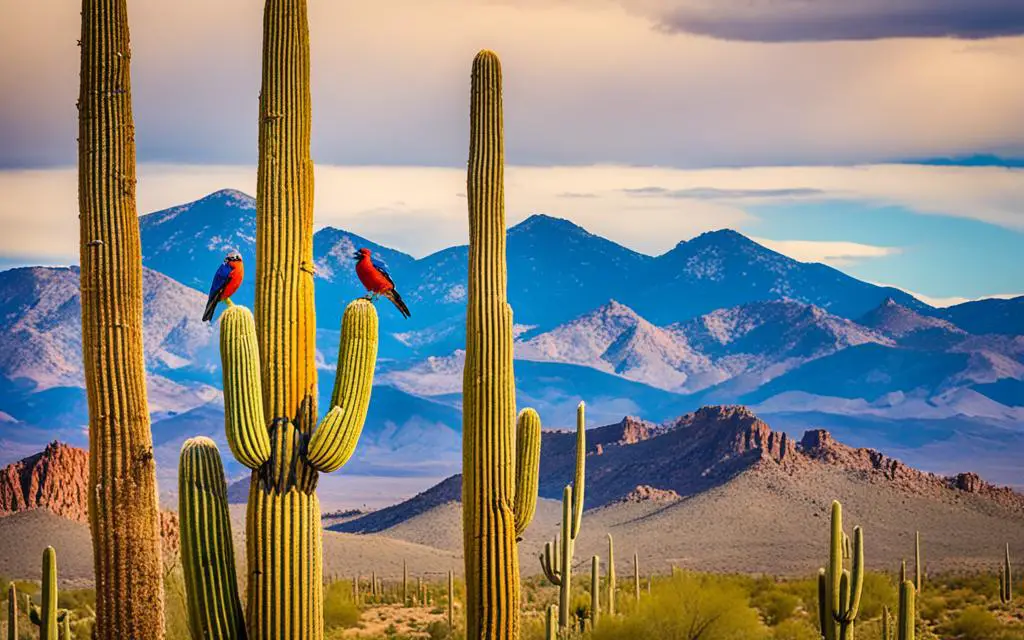
Comments are closed